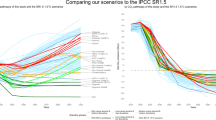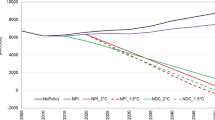Abstract
Based on a large number of energy-economic and integrated assessment models, the Energy Modeling Forum (EMF) 27 study systematically explores the implications of technology cost and availability for feasibility and macroeconomic costs of energy system transformations toward climate stabilization. At the highest level, the technology strategy articulated in all the scenarios in EMF27 includes three elements: decarbonization of energy supply, increasing the use of low-carbon energy carriers in end-use, and reduction of energy use. The way that the scenarios differ is in the degree to which these different elements of strategy are implemented, the timing of those implementations, and the associated macroeconomic costs. The study also discusses the value of individual technologies for achieving climate stabilization. A robust finding is that the unavailability of carbon capture and storage and limited availability of bioenergy have the largest impact on feasibility and macroeconomic costs for stabilizing atmospheric concentrations at low levels, mostly because of their combined ability to remove carbon from the atmosphere. Constraining options in the electric sector such as nuclear power, wind and solar energy in contrast has a much smaller impact on the cost of mitigation.





Similar content being viewed by others
Notes
Feasibility here relates to the ability of models to produce specific scenarios (see Section 4.2).
Throughout this study, primary energy accounting is based on the direct-equivalent method.
Several other options to produce negative emissions such as afforestation, enhanced weathering and direct air capture are discussed in the literature, but the majority of models in the EMF27 study included bioenergy coupled with CCS as the only negative emissions option.
References
Blanford GJ, Kriegler E, Tavoni M (2013) Harmonization vs. Fragmentation: Overview of Climate Policy Scenarios in EMF27. Climatic Change. doi:10.1007/s10584-013-0951-9
Chum et al. (2011) Bioenergy. In: Edenhofer et al. (ed.) IPCC Special Report on Renewable Energy Sources and Climate Change Mitigation. Cambridge University Press, Cambridge, UK
Clarke et al (2008) CO2 Emissions mitigation and technological advance: an updated analysis of advanced technology scenarios. PNNL Report Pacific Northwest National. Laboratory, Richmond
Clarke et al. (2012) Regional energy system variation in global models: Results from the Asian Modeling Exercise scenarios. Energy Economics.34:293–305
Edenhofer et al (2010) The economics of low stabilization: model comparison of mitigation strategies and costs. Energy Journal 31:11–48
Fisher et al. (2007) Issues related to mitigation in the long term context. In: Metz et al. (ed.) Climate Change 2007: Mitigation. Contribution of Working Group III to the Fourth Assessment Report of the IPCC. Cambridge University Press, Cambridge, UK
Kim et al. (this issue) Nuclear Energy Response in the EMF 27 Study. Climatic Change submitted
Kim S, MacCracken C, Edmonds J (2000) Solar energy technologies and stabilizing atmospheric CO2 concentrations. Progress in Photovoltaics 8:3–15
Krey V, Clarke L (2011) Role of renewable energy in climate mitigation: a synthesis of recent scenarios. Climate Policy 11:1131–1158
Kriegler et al. (2013) The role of technology for achieving climate policy objectives: overview of the EMF27 study on global technology and climate policy strategies. Climatic Change. doi:10.1007/s10584-013-0953-7
Luderer et al (2012) The economics of decarbonizing the energy system-results and insights from the RECIPE model intercomparison. Climatic Change 114:9–37
Luderer et al. (2013) The role of renewable energy in climate stabilization: results from the EMF 27 scenarios. Climatic Change. doi:10.1007/s10584-013-0924-z
McCollum et al. (2013) Fossil resource and energy security dynamics in conventional and carbon-constrained worlds. Climatic Change. doi:10.1007/s10584-013-0939-5
Riahi et al (2012) Chapter 17 - Energy pathways for sustainable development. Global energy assessment - toward a sustainable future. Cambridge University Press, Cambridge, pp 1203–1306
Sugiyama et al. (submitted for this issue) Energy efficiency potentials for global climate change mitigation. Climatic Change
Rose et al. (this issue) Bioenergy in energy transformation and climate management. Climatic Change. doi:10.1007/s10584-013-0965-3
Tavoni M, Socolow R (2013) Modeling meets science and technology: an introduction to a special issue on negative emissions. Climatic Change 118:1–14
Tavoni M, Tol R (2010) Counting only the hits? The risk of underestimating the costs of stringent climate policy. Climatic Change 100:769–778
Acknowledgements
Volker Krey’s, Gunnar Luderer’s and Elmar Kriegler’s contribution was supported by the European Union Seventh Framework Programme FP7/2007-2013 under grant agreement n° 282846 (LIMITS). Leon Clarke’s contribution was supported by the Office of Science of the U.S. Department of Energy as part of the Integrated Assessment Research Program.
Author information
Authors and Affiliations
Corresponding author
Additional information
This article is part of the Special Issue on "The EMF27 Study on Global Technology and Climate Policy Strategies" edited by John Weyant, Elmar Kriegler, Geoffrey Blanford, Volker Krey, Jae Edmonds, Keywan Riahi, Richard Richels, and Massimo Tavoni.
Electronic supplementary material
Below is the link to the electronic supplementary material.
ESM 1
(DOCX 2589 KB)
Rights and permissions
About this article
Cite this article
Krey, V., Luderer, G., Clarke, L. et al. Getting from here to there – energy technology transformation pathways in the EMF27 scenarios. Climatic Change 123, 369–382 (2014). https://doi.org/10.1007/s10584-013-0947-5
Received:
Accepted:
Published:
Issue Date:
DOI: https://doi.org/10.1007/s10584-013-0947-5




